The Top-Down and Bottom-Up approaches define how organizations navigate decision-making and operational execution. These approaches delineate management styles and embody the varying cultures within organizations, highlighting distinct paths towards achieving business objectives.
Introduction to Management Approaches
The Top-Down organizational structure is known for its hierarchical decision-making process driven by senior management, emphasizing leadership and control. In contrast, the Bottom-Up approach champions a more inclusive and democratic strategy, where ideas and feedback from all levels of the workforce shape strategic decisions.
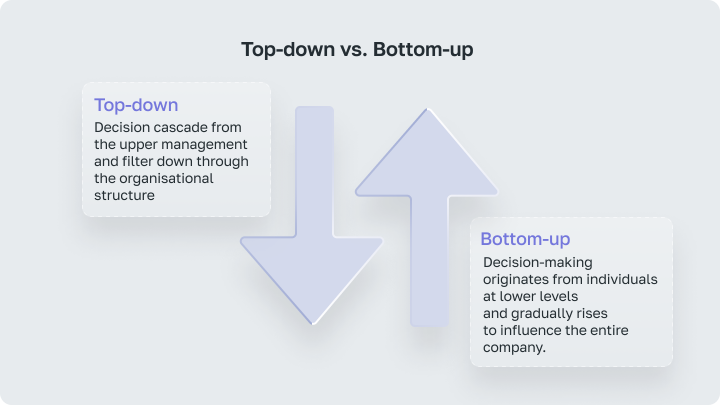
This article provides an answer to how these divergent methodologies impact organizational success, considering their unique benefits, challenges, and the factors that influence their implementation.
Exploring the Top-Down Approach
Definition and Mechanics of Top-Down Management
Top-down strategy is distinguished by its systematic allocation of authority and accountability, initiating from the highest levels of organizational leadership and extending down to the operational workforce. The top-down hierarchy arrangement facilitates a streamlined flow of directives, with strategic objectives and policies being devised by the top-tier leadership.
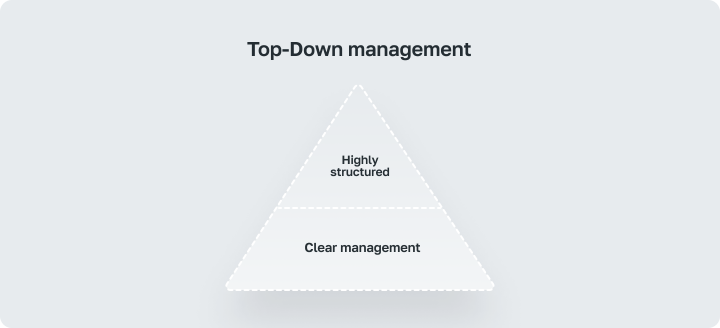
The primary aim is to enhance organizational efficiency and maintain centralized oversight, enabling swift decision-making and uniform implementation of strategies across all operational facets. This management model is adept at minimizing ambiguities and ensuring that all units within the organization march towards common goals under a unified strategic banner.
When to Use the Top-Down Approach
The top-down approach proves most effective in scenarios demanding quick, decisive leadership actions and where a high degree of uniformity in operational execution is imperative. It excels in industries where regulatory compliance and strict procedural controls are critical, protecting against compliance breaches and operational risk.
Furthermore, top-down planning is particularly valuable during significant organizational changes or restructuring phases, where clear, directive leadership is essential to steer the organization through transitional periods with minimized disruptions. By centralizing decision-making, it ensures that change initiatives are implemented cohesively, aligning with the strategic objectives and mitigating resistance to change.
Advantages of Top-Down Management
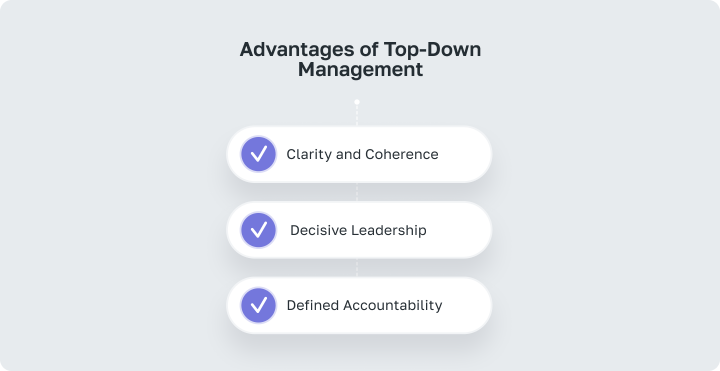
 Clarity and Coherence
Clarity and Coherence
Central to the top-down management style is the establishment of a clear decision-making hierarchy. This structure ensures that organizational goals and strategies are articulated from the top, fostering a common understanding and consistent execution throughout the organization. It eliminates ambiguity and aligns the efforts of each department and individual toward collective goals.
 Decisive Leadership
Decisive Leadership
In situations that require quick decision-making, such as crises or opportunities that require rapid response, the top-down approach empowers leaders to act decisively. Centralized decision-making authority eliminates the delays inherent in consensus-seeking processes, allowing organizations to meet challenges or seize opportunities with agility.
 Defined Accountability
Defined Accountability
Roles and responsibilities are simplified by the hierarchical nature of top-down management. This clarity in the organizational structure facilitates efficient tracking and evaluation of individual and team performance against pre-defined metrics and goals, promoting accountability at all levels.
Disadvantages of Top-Down Management
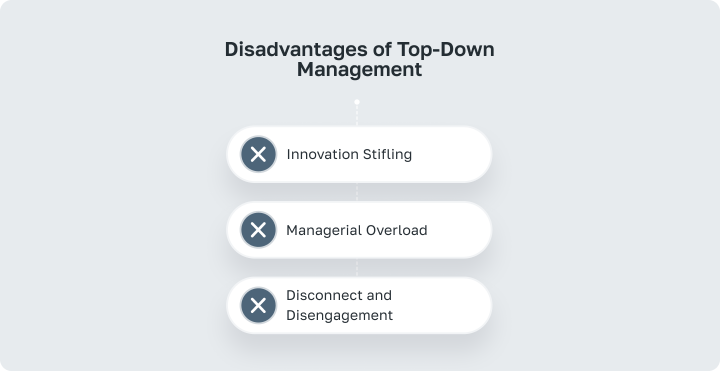
 Innovation Stifling
Innovation Stifling
While the top-down approach ensures organizational alignment and decision-making efficiency, it can inadvertently quash creativity at the grassroots level. The emphasis on directives coming from the top might discourage lower-level employees from contributing ideas, potentially overlooking innovative solutions that could drive the organization forward.
 Managerial Overload
Managerial Overload
Consolidating decision-making power among top executives can lead to a bottleneck, where senior leaders are overwhelmed by the sheer volume of decisions to be made. This slows down the decision-making process and increases the risk of burnout among senior management, impacting their ability to lead effectively.
 Disconnect and Disengagement
Disconnect and Disengagement
The clear division between decision-makers and those at the operational level can engender a sense of disconnection. Employees who feel their insights and feedback are undervalued may experience diminished morale and engagement. This disengagement not only affects individual productivity but can also lead to a wider organizational culture where innovation and proactive problem-solving are stifled.
Understanding the Bottom-Up Approach
Characteristics of Bottom-Up Management
The bottom-up management approach represents a paradigm shift from traditional hierarchical models, positioning itself as a method that harnesses the collective insight and creativity of all organizational members. This strategy is built on the premise that those working on the front lines possess invaluable perspectives and insights that, when aggregated, can lead to superior decision-making and innovative problem-solving.
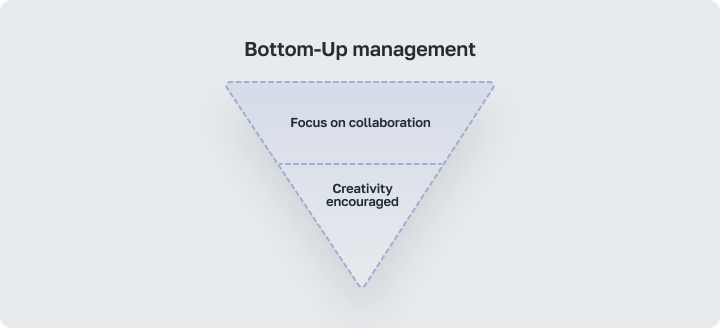
Characteristics of Bottom-Up Management:
- Empowerment and Engagement: Central to the bottom-up approach is the empowerment of employees at every level. By actively involving staff in the decision-making process, organizations can foster a culture of ownership and responsibility. This empowerment enhances individual and team motivation and encourages a deeper commitment to the organization’s goals and objectives.
- Decentralized Decision-Making: Unlike the top-down approach where decisions are made at the apex of the hierarchy, the bottom-up approach decentralizes decision-making. By enabling decisions to be made closer to the point of action, it ensures that responses to challenges and opportunities are swift and relevant. This agility is crucial in dynamic markets, where adaptability can provide a competitive edge.
- Innovation and Creativity: The collaborative ethos inherent in the bottom-up approach nurtures an environment ripe for innovation. When employees feel their ideas are valued and have a pathway to influence organizational direction, creativity flourishes. This environment not only generates innovative solutions to internal challenges but can also lead to the development of new products, services, and processes that drive business growth.
When to Use the Bottom-Up Approach
The bottom-up approach is particularly effective in environments where innovation and agility are paramount. Organizations operating in rapidly changing industries, those seeking to foster a culture of continuous improvement, or companies aiming to enhance employee satisfaction and retention may find this approach especially beneficial. It’s also well-suited to projects requiring diverse input and creative solutions, as it leverages the collective intelligence and creativity of the entire workforce.Moreover, in scenarios where employee buy-in is critical for the success of organizational initiatives, the bottom-up approach can be instrumental. By involving employees in the planning and decision-making processes, organizations can ensure that changes are met with less resistance and greater enthusiasm.
In essence, the bottom-up approach to management offers a dynamic and inclusive alternative to traditional hierarchies, promoting a culture of empowerment, rapid adaptability, and collective innovation. Its successful implementation hinges on genuine leadership commitment to valuing and acting on employee contributions, ensuring that the organizational structure and processes support this participatory ethos.
Advantages of Bottom-Up Management
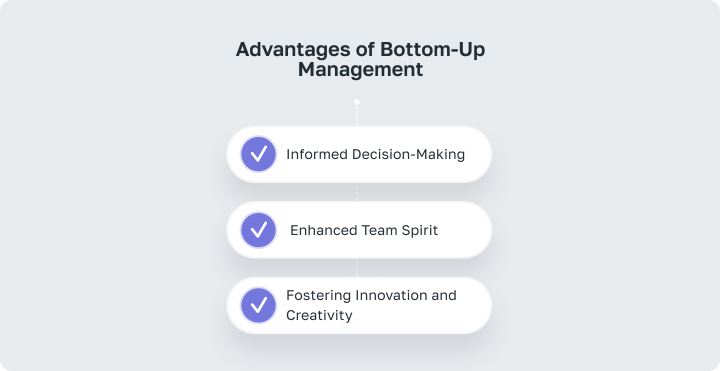
 Informed Decision-Making
Informed Decision-Making
By involving those closest to the day-to-day operations in the decision-making process, the Bottom-Up approach ensures that decisions are not only well-informed but are also practical and grounded in operational reality. This hands-on perspective often leads to more effective solutions that are tailored to the specific challenges and opportunities faced by the organization.
 Enhanced Team Spirit
Enhanced Team Spirit
The ethos of inclusivity and respect for every team member’s contribution significantly boosts morale. When employees feel their voices are heard and their inputs valued, it cultivates a sense of belonging and commitment to the team and the organization at large. This heightened sense of team spirit translates into increased motivation and drive, contributing to overall organizational success.
 Fostering Innovation and Creativity
Fostering Innovation and Creativity
By empowering employees across levels to share their ideas and innovations, a Bottom-Up management strategy transforms the organization into a dynamic and creative powerhouse. This openness to new ideas not only drives the organization forward, but also positions it as a leader in innovation within its industry.
Disadvantages of Bottom-Up Management
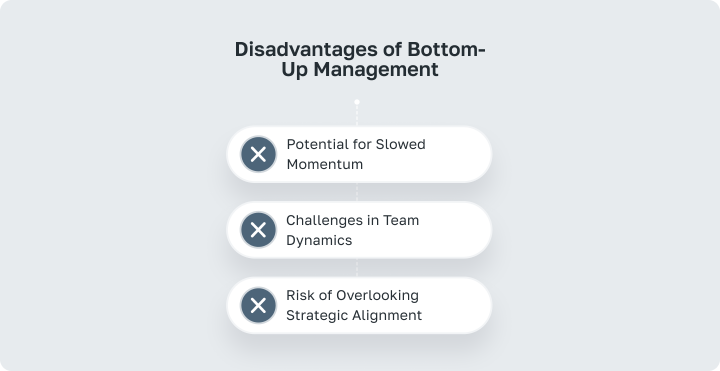
 Potential for Slowed Momentum
Potential for Slowed Momentum
While the inclusive nature of decision-making under the Bottom-Up approach is one of its greatest strengths, it can sometimes act as a double-edged sword. The extensive process of gathering and synthesizing input from various levels of the organization, although beneficial for making informed decisions, can slow down the pace at which projects are implemented. Balancing thoroughness with efficiency becomes a key challenge in this context.
 Challenges in Team Dynamics
Challenges in Team Dynamics
The shift towards a more democratic decision-making process may also introduce complexities in team dynamics. Managing consensus and ensuring alignment across diverse viewpoints require adept leadership and conflict resolution skills. The transition to a Bottom-Up approach may necessitate a reevaluation of leadership and team management strategies to maintain cohesion and momentum.
 Risk of Overlooking Strategic Alignment
Risk of Overlooking Strategic Alignment
While empowering operational-level employees to contribute to decision-making enriches the process with valuable insights, there exists a risk that decisions made might not always align with the broader strategic objectives of the organization. Ensuring that decentralized decision-making does not compromise the organization’s strategic direction demands robust communication channels and a clear articulation of organizational goals and objectives.
Effective Management Strategies
Cross-Functional Team Management Techniques
Managing cross-functional teams, which comprise members from various departments with diverse expertise, is crucial for complex projects requiring a wide range of skills. Effective management of these teams hinges on:
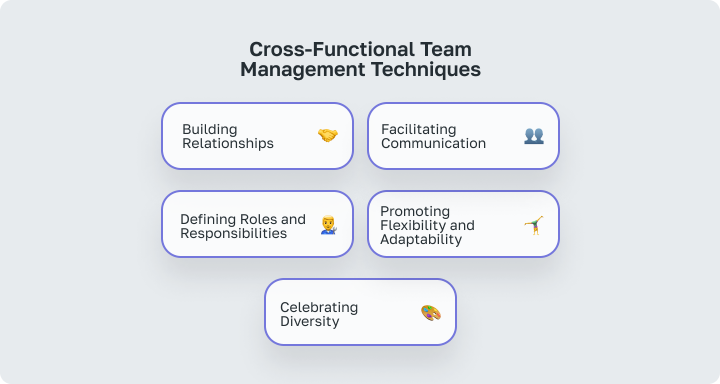
Building Relationships
Establishing strong interpersonal relationships among team members is foundational. Encourage open communication and mutual respect to foster a collaborative environment where everyone feels valued and understood.Facilitating Communication
Create channels for easy and clear communication. Regular meetings, project management tools, and informal check-ins can help keep everyone on the same page, ensure alignment, and facilitate the exchange of ideas and feedback.
Defining Roles and Responsibilities
Clearly articulate each team member’s role, responsibilities, and how they contribute to the project’s objectives. This clarity helps prevent overlap, reduces confusion, and enhances individual accountability.
Promoting Flexibility and Adaptability
Cross-functional teams often encounter unforeseen challenges. Encourage a mindset of flexibility and problem-solving to navigate these challenges effectively.
Celebrating Diversity
Leverage the diverse backgrounds, skills, and perspectives of team members. This diversity can drive innovation and creative problem-solving.
Achieving Balance Between Top-Down and Bottom-Up Approaches
A balanced management approach leverages the strengths of both top-down and bottom-up strategies to create a dynamic, responsive, and inclusive project management environment.
Here’s how to achieve this balance:
- Integrate Strategic Direction with Ground-Level Insights: While the top-down approach provides clear strategic direction, incorporating insights from the bottom-up approach ensures that decisions are informed by operational realities and employee insights.
- Empower Decision-Making at All Levels: Allow team members to make decisions at the operational level, while ensuring that these decisions align with the project’s strategic objectives. This empowers employees and ensures a more agile and responsive project execution.
- Foster a Culture of Communication: Establish strong communication channels that facilitate the flow of information both upwards and downwards. This ensures that strategic decisions are informed by ground-level data and that employees are aware of the broader strategic goals.
- Encourage Collaboration and Participation: Create opportunities for team members to contribute ideas and feedback on project strategies and execution plans. This improves project outcomes and enhances team engagement and satisfaction.
- Utilize Flexible Management Tools: Implement project management tools that support both top-down strategic planning and bottom-up feedback mechanisms. These tools should offer flexibility to adapt to the changing dynamics of the project and the organization.
Conclusion
Summary: The Importance of Choosing the Right Approach
The debate between “bottom-up vs top-down” approaches is critical for cross-functional team management and achieving an organizational balance. This involves creating an environment where team members feel valued, and their diverse perspectives are leveraged for innovative problem-solving. It’s essential to clearly define roles and responsibilities to avoid overlaps and confusion, enhancing individual accountability. Encouraging flexibility and adaptability helps teams navigate unforeseen challenges effectively. Recognizing and celebrating the diversity within teams can drive innovation and lead to creative solutions.
Achieving a balance between Top-Down and Bottom-Up Approaches involves integrating strategic direction with insights from operational levels, empowering decision-making across the organization. Establishing robust communication channels ensures the flow of information in both directions, aligning strategic objectives with ground-level operations. Encouraging collaboration and participation enhances project outcomes, while flexible management tools support the dynamic needs of projects and teams. This balanced approach leverages the clarity of Top-Down strategies with the inclusiveness and adaptability of Bottom-Up methods, fostering a productive and engaged project environment.
Final Thoughts on Adaptive Management
Adaptive management is not merely about flexibility in planning and execution but also embodies a proactive stance towards learning and evolution based on project outcomes and changing external conditions. Embracing this adaptive mindset allows project managers and leaders to navigate the complexities of modern projects more effectively, ensuring not just the achievement of short-term goals but also aligning with long-term strategic objectives.
The choice of management approach, therefore, should be a thoughtful decision, reflective of the organization’s core values, project demands, and the overarching strategic vision. Adaptive management emerges as a critical strategy in this context, ensuring organizations are prepared to face the challenges of today and poised to innovate and lead in an uncertain future.